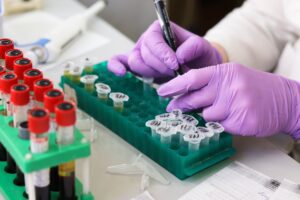Create cutting-edge data architecture for highly specialized Life Sciences
Data pipelines are simple to understand: they’re systems or channels that allow data to flow from one point to another in a structured manner. But structuring them for complex use cases in the field of genomics is anything but simple.
Genomics relies heavily on data pipelines to process and analyze large volumes of genomic data efficiently and accurately. Given the vast amount of details involving DNA and RNA sequencing, researchers require robust genomics pipelines that can process, analyze, store, and retrieve data on demand.
It’s essential to build genomics pipelines that serve the various functions of genomics research and optimize them to conduct accurate and efficient research faster than the competition. Here’s how RCH is helping your competitors implement and optimize their genomics data pipelines, along with some best practices to keep in mind throughout the process.
Early-stage steps for implementing a genomics data pipeline
Whether you’re creating a new data pipeline for your start-up or streamlining existing data processes, your entire organization will benefit from laying a few key pieces of groundwork first. These decisions will influence all other decisions you make regarding hosting, storage, hardware, software, and a myriad of other details.
Defining the problem and data requirements
All data-driven organizations, and especially the Life Sciences, need the ability to move data and turn them into actionable insights as quickly as possible. For organizations with legacy infrastructures, defining the problems is a little easier since you have more insight into your needs. For startups, a “problem” might not exist, but a need certainly does. You have goals for business growth and the transformation of society at large, starting with one analysis at a time. So, start by reviewing your projects and goals with the following questions:
- What do your workflows look like?
- How does data move from one source to another?
- How will you input information into your various systems?
- How will you use the data to reach conclusions or generate more data?
Leaning into your projects and goals and the outcomes of the above questions in the planning phase will lead to an architecture that will be laid out to deliver the most efficient results based on how you work. The answers to the above questions (and others) will also reveal more about your data requirements, including storage capacity and processing power, so your team can make informed and sustainable decisions.
Data collection and storage
The Cloud has revolutionized the way Life Sciences companies collect and store data. AWS Cloud computing creates scalable solutions, allowing companies to add or remove space as business dictates. Many companies still use on-premise servers, while others are using a hybrid mix.
Part of the decision-making process may involve compliance with HIPAA, GDPR, the Genetics Diagnostics Act, and other data privacy laws. Some regulations may prohibit the use of public Cloud computing. Decision-makers will need to consider every angle, every pro, and every con to each solution to ensure efficiency without sacrificing compliance.
Data cleaning and preprocessing
 Raw sequencing data often contains noise, errors, and artifacts that need to be corrected before downstream analysis. Pre-processing involves tasks like trimming, quality filtering, and error correction to enhance data quality. This helps maintain the integrity of the pipeline while improving outputs.
Raw sequencing data often contains noise, errors, and artifacts that need to be corrected before downstream analysis. Pre-processing involves tasks like trimming, quality filtering, and error correction to enhance data quality. This helps maintain the integrity of the pipeline while improving outputs.
Data movement
Generated data typically writes to local storage and is then moved elsewhere, such as the Cloud or network-attached storage (NAS). This gives companies more capacity, plus it’s cheaper. It also frees up local storage for instruments which is usually limited.
The timeframe when the data gets moved should also be considered. For example, does the data get moved at the end of a run or as the data is generated? Do only successful runs get moved? The data format can also change. For example, the file format required for downstream analyses may require transformation prior to ingestion and analysis. Typically, raw data is read-only and retained. Future analyses (any transformations or changes) would be performed on a copy of that data.
Data disposal
What happens to unsuccessful run data? Where does the data go? Will you get an alert? Not all data needs to be retained, but you’ll need to specify what happens to data that doesn’t successfully complete its run.
Organizations should also consider upkeep and administration. Someone should be in charge of responding to failed data runs as well as figuring out what may have gone wrong. Some options include adding a system response, isolating the “bad” data to avoid bottlenecks, logging the alerts, and identifying and fixing root causes.
Data analysis and visualization
Visualizations can help speed up analysis and insights. Users can gain clear-cut answers from data charts and other visual elements and take decisive action faster than reading reports. Define what these visuals should look like and the data they should contain.
Location for the compute
Where the compute is located for cleaning, preprocessing, downstream analysis, and visualization is also important. The closer the data is to the computing source, the shorter distance it has to travel, which translates into faster data processing.
Optimization techniques for genomics data pipelines
Establishing a scalable architecture is just the start. As technology improves and evolves, opportunities to optimize your genomic data pipeline become available. Some of the optimization techniques we apply include: 
Parallel processing and distributed computing
Parallel processing involves breaking down a large task into smaller sub-tasks which can happen simultaneously on different processors or cores within a single computer system. The workload is divided into independent parts, allowing for faster computation times and increased productivity.
Distributed computing is similar, but involves breaking down a large task into smaller sub-tasks that are executed across multiple computer systems connected to one another via a network. This allows for more efficient use of resources by dividing the workload among several computers.
Cloud computing and serverless architectures
Cloud computing uses remote servers hosted on the internet to store, manage, and process data instead of relying on local servers or personal computers. A form of this is serverless architecture, which allows developers to build and run applications without having to manage infrastructure or resources.
Containerization and orchestration tools
Containerization is the process of packaging an application, along with its dependencies and configuration files, into a lightweight “container” that can easily deploy across different environments. It abstracts away infrastructure details and provides consistency across different platforms.
Containerization also helps with reproducibility. Users can expect better performance if the computer is in close proximity to the data. It can also be optimized for longer-term data retention by moving data to a cheaper storage area when feasible.
Orchestration tools manage and automate the deployment, scaling, and monitoring of containerized applications. These tools provide a centralized interface for managing clusters of containers running on multiple hosts or cloud providers. They offer features like load balancing, auto-scaling, service discovery, health checks, and rolling updates to ensure high availability and reliability.
Caching and data storage optimization
We explore a variety of data optimization techniques, including compression, deduplication, and tiered storage, to speed up retrieval and processing. Caching also enables faster retrieval of data that is frequently used. It’s readily available in the cache memory instead of being pulled from the original source. This reduces response times and minimizes resource usage.
Best practices for data pipeline management in genomics
As genomics research becomes increasingly complex and capable of processing more and different types of data, it is essential to manage and optimize the data pipeline efficiently to create accurate and reproducible results. Here are some best practices for data pipeline management in genomics.
- Maintain proper documentation and version control. A data pipeline without proper documentation can be difficult to understand, reproduce, and maintain over time. When multiple versions of a pipeline exist with varying parameters or steps, it can be challenging to identify which pipeline version was used for a particular analysis. Documentation in genomics data pipelines should include detailed descriptions of each step and parameter used in the pipeline. This helps users understand how the pipeline works and provides context for interpreting the results obtained from it.
- Test and validate pipelines routinely. The sheer complexity of genomics data requires careful and ongoing testing and validation to ensure the accuracy of the data. This data is inherently noisy and may contain errors which will affect downstream processes.
- Continuously integrate and deploy data. Data is only as good as its accessibility. Constantly integrating and deploying data ensures that more data is readily usable by research teams.
- Consider collaboration and communication among team members. The data pipeline architecture affects the way teams send, share, access, and contribute to data. Think about the user experience and seek ways to create intuitive controls that improve productivity.
Start Building Your Genomics Data Pipeline with RCH Solutions
About 1 in 10 people (or 30 million) in the United States suffer from a rare disease, and in many cases, only special analyses can detect them and give patients the definitive answers they seek. These factors underscore the importance of genomics and the need to further streamline processes that can lead to significant breakthroughs and accelerated discovery.
But implementing and optimizing data pipelines in genomics research shouldn’t be treated as an afterthought. Working with a reputable Bio-IT provider that specializes in the complexities of Life Sciences gives Biopharmas the best path forward and can help build and manage a sound and extensible scientific computing environment, that supports your goals and objectives, now and into the future. RCH Solutions understands the unique requirements of data processing in the context of genomics and how to implement data pipelines today while optimizing them for future developments.
Let’s move humanity forward together — get in touch with our team today.
Sources
https://www.ncbi.nlm.nih.gov/pmc/articles/PMC5580401/
https://www.seagate.com/blog/what-is-nas-master-ti/
https://greatexpectations.io/blog/data-tests-failed-now-what




